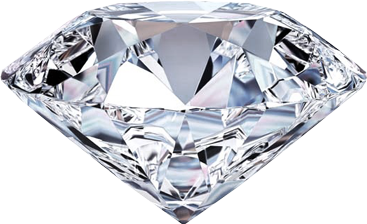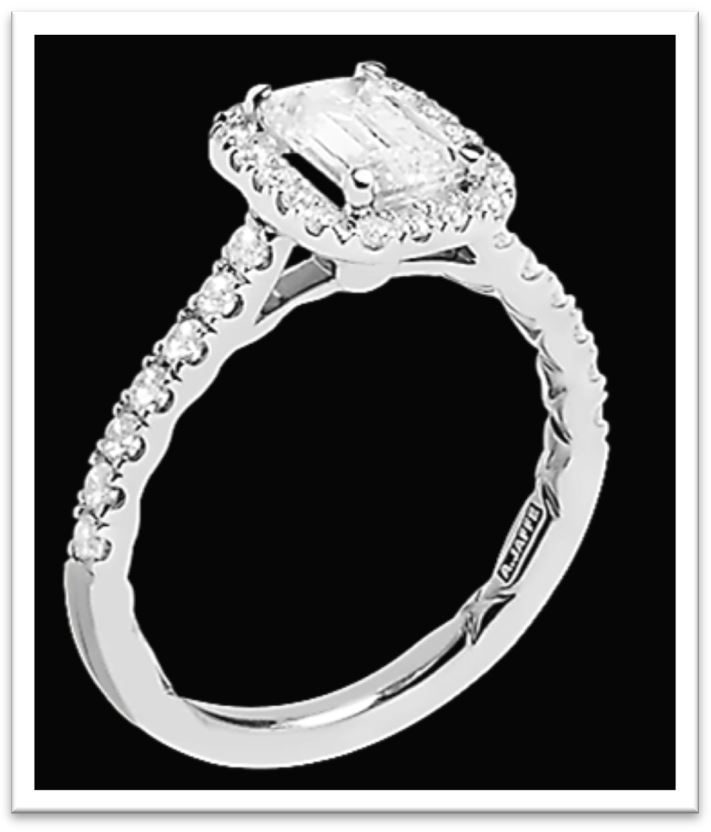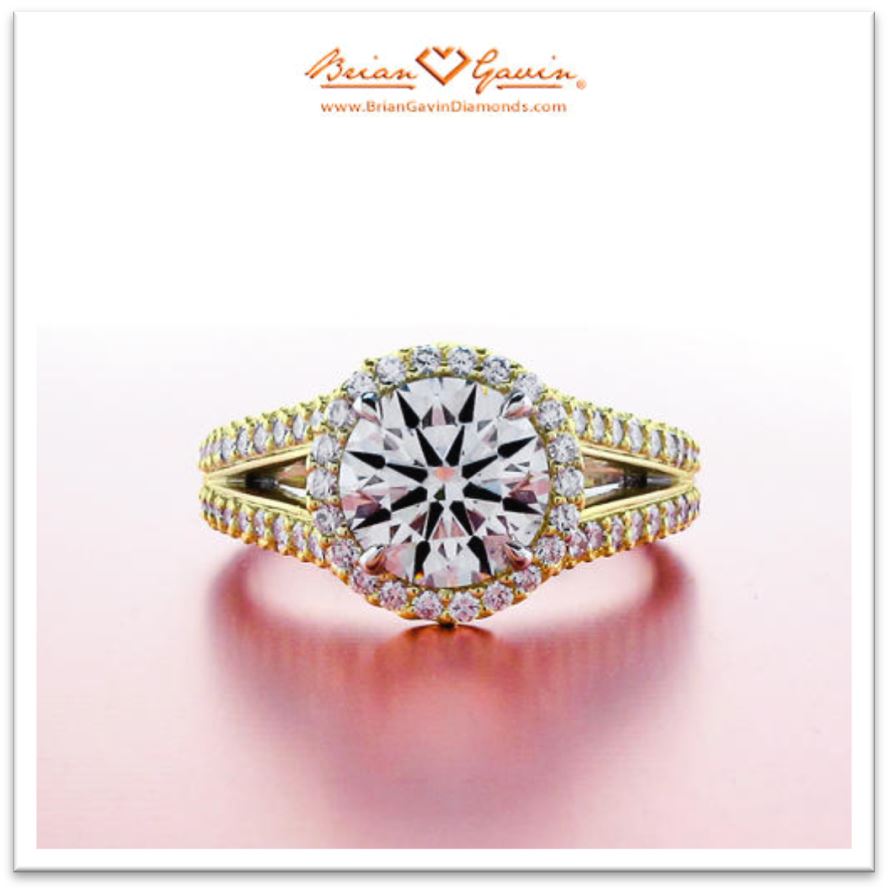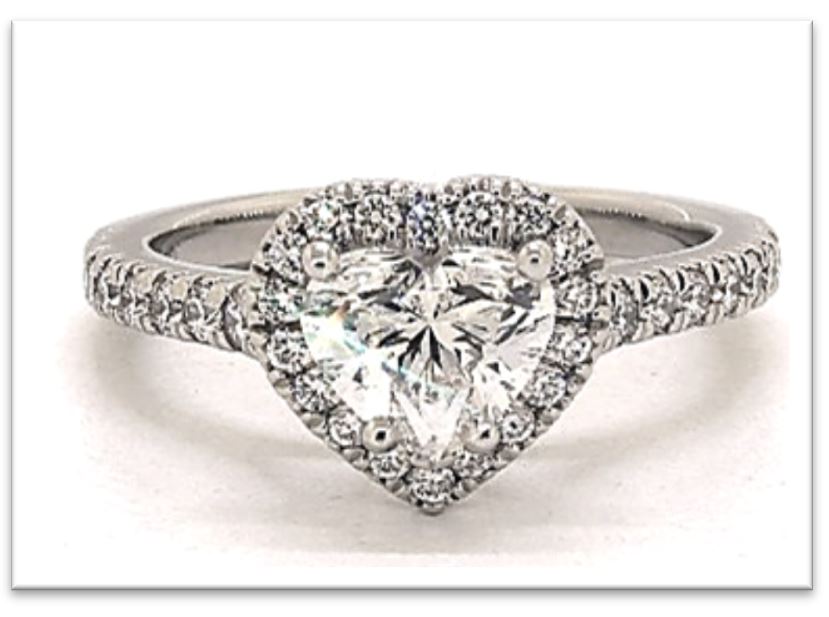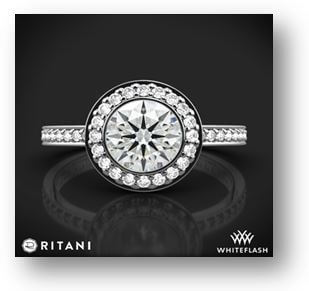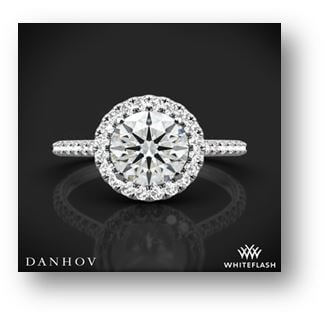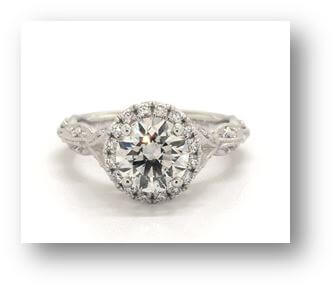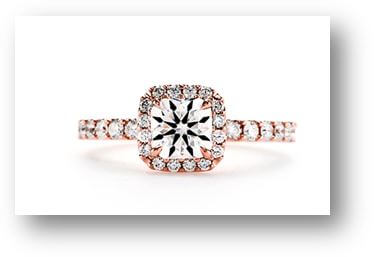Top 15 Halo Engagement Rings
Top 15 Halo Engagement Rings
Posted by Sharif Khan on 4th Jul 2019
The Top 15 Unique Halo Engagement Rings
A halo engagement ring is one of the most spectacular styles around. It consists of a beautiful diamond or gemstone, circled in by a collection of pavé or micro-pavé diamonds or colored gemstones. This setting of the diamond or gemstone makes it appear much larger than it actually is, and creates an enchanting engagement ring that will be absolutely adored for years to come.
Since the creation of the halo engagement rings, there have been some variations created of this style that has lead to the design of the most incredible and unique halo engagement rings. Here are our top ten:
Round Cut Halo Engagement Ring
Watch this Ring in 360° HD
If you are looking for a ring that really stands out, this sapphire circled diamond engagement ring from James Allen is what you have been looking for.
The brilliant 0.70-carat Excellent Cut Round diamond is really made to pop with an outside circle of small sapphires. The small blue stones surround the diamond to increase its brilliance, making it pop out with a wonderful sparkle.
The blue sapphires are contrary to tradition and make this halo engagement ring unique in its own way. The clear diamonds which trace down along the band help the blue sapphires appear more striking, especially set along the white gold.
This halo engagement ring was made to stand out, and it will be an incredibly unique, yet special, ring bought for the big I do.
Pink and White Diamond Halo Ring
Watch this Ring in 360° HD
Blue Nile have this incredibly sweet ring on offer. The halo design features circles of Round cut pink and white diamonds, all set perfectly in 18K rose gold and platinum.
It might seem like a simple ring at first, but it is a delicate take on the usual halo engagement rings. It doesn’t feature a super large center diamond and instead opts for a smaller Round cut center stone that is part of the beautiful rose gold and platinum design.
The colors work so well together to create a delicate halo engagement ring which is both vintage and modern. The ring was designed to show off the circular design, with no distractions from that. The simple platinum band allows the focal point to shine, and it really does shine and sparkle!
Pear Shaped Halo Engagement Ring
Watch this Ring in 360° HD
This Pear Shaped Halo Ring from James Allen is a vintage take on the traditional halo engagement ring. The Pear Cut diamond is of great quality and creates a wonderful twist in this engagement ring, set beautifully in smaller diamonds which also extend down the band.
The gorgeous 14K yellow gold metal is not as commonly found in halo engagement rings, but with the Pear cut diamond, it works to create a warm, enchanting feeling in the ring.
While this is more of a modern style, the yellow gold and Pear cut diamond work together to create a timeless engagement ring with a wonderfully vintage feel, perfect for someone looking for something a little more timeless.
Mila Halo Cushion Cut Diamond Engagement Ring
Watch this Ring in 360° HD
This spectacular ring from Blue Nile is a complete showstopper. It is the ultimate portrayal of over-the-top opulence and drama but manages to do so in a classy, elegant way.
The ring is a triple halo ring, with three layers of pavé diamonds framing the beautiful center Cushion cut diamond. There are over 100 hand-set diamonds in a pavé setting and four baguettes which create a unique, timeless piece that is the highest form of glamour.
The band splits under the diamond and joins together along the lower band, with both aisles of the band set with more smaller diamonds. It is the ultimate sparkle and shine ring that will capture attention in any light, and be the perfect promise of an incredible life to be spent together.
Verragio 2T Couture Two-Tone Diamond Engagement Ring
Watch this Ring in 360° HD
From the Couture Collection at Whiteflash, this engagement ring is a truly spectacular piece.
The two-tone rose gold profile, along with the Round Brilliant Cut Diamond Melee, work to create an enchanting piece to home the diamond of your choice.
The rose gold feature sits underneath the top diamond piece, and is dotted with smaller diamonds. It adds a wonderful dimension to the ring which gives it an air of mystery and elegance. The band is expertly crafted, with diamonds paved along the side, leading up in growing branches on the side, with the inside of the ring being dotted with white gold.
It is the ring that keeps on giving, and you will notice something new every time you look at the ring. The setting itself has been designed to hold a center diamond between 1.75 and 2.50 carats, truly fit for that someone special in your life.
Cushion Modified Cut Halo Engagement Ring
Watch this Ring in 360° HD
At first, when people think of a halo engagement ring, they imagine a white diamond set in platinum or white gold. This James Allen custom engagement ring takes the halo style to a new level with the centering of a yellow Cushion cut diamond.
Surrounded by white diamonds, the yellow 1.21-carat diamond appears much larger than its already impressive size, and its yellow color adds a pop of uniqueness to the ring. Cushion cut diamonds are also fast becoming popular among modern brides, so this really is the ring for a woman who knows her own style.
This ring is dazzling, enchanting and perfectly over the top with the additional small diamonds set along the band. It is truly extravagant, in all the best ways, while still being unique enough to suit that special someone.
Bella Vaughan Cushion Halo Hand Engraved Engagement Ring
Watch this Ring in 360° HD
Designed by Bella Vaughan for Blue Nile, this engagement ring is fit for royalty. Handcrafted in platinum, this ring has incredible detailing that extends throughout the entire ring.
Four diamonds sit on each corner post of the square halo, while smaller diamonds line along the rest of the setting. Along the band, small diamonds extend down, outlined by hand detailing that is breathtaking.
The whole ring has been designed to highlight the center stone of choice, which can be a Princess, Oval, Radiant, Round or Oval cut – whichever is suited to what you want. The center diamond will really stand out in this halo design, all while working together with all the other elements of the ring to create a timeless masterpiece which is a ring that really is fit for a queen.
A. Jaffe Seasons of Love Halo Diamond Engagement Ring
Watch this Ring in 360° HD
An Emerald Cut diamond would place perfectly in this halo style engagement ring. It hails from the Whiteflash Seasons of Love collection, which showcases some truly spectacular rings.
This play on the traditional halo style sees a diamond pavé band leading up to culminate in an almost cathedral type arch, lifting up the emerald cut diamond, giving it a chance to capture light and shine brilliantly. The diamonds placed in the halo of the ring help to make the center emerald cut diamond seem larger than it is.
The inside of the ring is quilted, giving a luxurious fit which makes the ring comfortable to wear day in and out.
The whole ring has been expertly crafted, and speaks of elegance and romance, with the unique Emerald cut diamond stealing the show and shining bright.
Bella Halo Micro Pavé
Watch this Ring in 360° HD
Brian Gavin Diamonds have crafted this beautiful halo engagement ring that is slightly different from the traditional style.
The split shank halo setting shows off the signature Brian Gavin melee micro pavé which is handset into three different sides of the custom setting.
The center stone is allowed to shine and sparkle completely, with the help from the surrounding halo diamonds which makes the center stone appear larger than it is. The gold metal gives the ring a warmer feel overall, which makes it an enchanting and timeless piece.
Having a split band gives the ring a fuller look, while still appearing dainty and elegant when worn on the finger, not seeming too bulky.
Brian Gavin Diamonds engagement rings are crafted and designed by the finest craftsmen who ensure that every piece is a lifelong treasure.
Heart Shaped Halo Engagement Ring in Platinum
Watch this Ring in 360° HD
What better promise of love to give to that someone special than this unique heart-shaped halo engagement ring. The heart-shaped diamond is a symbol of absolute love and adoration, and this ring really is a one-of-a-kind design.
The pavé set diamonds perfectly frame the 0.70 carat Heart cut diamond which has an incredible brilliance and unique sparkle, thanks to its shape and cut. The diamond appears much larger than its actual carat weight, while still holding its perfect heart shape.
The platinum setting only adds to the pure innocence of the ring, and helps create the feel of the perfect promise of love. James Allen have managed to capture the essence of love in this ring and it really is a unique version of the traditional halo engagement ring.
14K White Gold Ritani Vintage Halo Micropavé Halo Diamond Engagement Ring
Watch this Ring in 360° HD
From the Endless Love Collection by Ritani, this ring encompasses a vintage look and timeless elegance.
A circular halo, set with round cut diamonds, circles around a center stone that plays off all of the small diamonds to be radiant with a brilliant shine. The diamond melee perfectly frames a gorgeous center stone.
The band of the ring is also set with pavé diamonds which only adds to the sparkle of the ring. Diamonds upon diamonds adorn the ring, creating a breathtakingly elegant ring that will steal the show wherever it goes.
14K White Gold Danhov Per Lei Halo Diamond Engagement Ring
Watch this Ring in 360° HD
A wonderfully crafted halo of a diamond melee surrounds a center diamond, and the whole ring just shines as brilliantly as possible.
The understructure of the ring gives an open profile view of the center diamond, with the under gallery bands adorned with more brilliant round cut diamonds, there is sparkle at every angle with the ring.
The shank of the ring is lined with pavé set diamonds, which lead up and lift towards the center halo, elevating the ring to stand up high above the ring finger, showcasing the sparkle and radiance that the diamonds have to offer.
It is a truly exceptional piece, with exquisite beauty and light.
14K White Gold MilgrainNavette Halo Engagement Ring
Watch this Ring in 360° HD
This timeless piece is beautifully intricate with twists and curves and diamonds to catch the eye at every angle.
The band is set with small round cut diamonds, a navette design and milgrain detailing to give a very delicate yet detailed design, leading up to a brilliant halo of round cut diamonds that perfectly frame a center stone.
Every view of the ring gives you a stunning shine, with small details to find all over. The under gallery of the ring is also set with small leave designs with a round cut diamond in the middle, patterned with milgrain detailing. This under gallery lifts the center halo and diamond up for the best view from above.
Elegant and delicate, this ring shines radiantly and offers the most intricate details all over.
14K White Gold Enchanted Filigree Engagement Ring
Watch this Ring in 360° HD
The band of the ring features a petite filigree engraving, studded with small diamond accents that bring an extra sparkle to the special detailing. The detailing of the diamonds and the engraving of the ring have a very organic feel, leading up ever so softly to the center stone.
An oval-shaped halo, set with round cut diamonds, frames the center stone so wonderfully, creating a mirror effect with light reflecting off of every diamond and angle.
Expert craftsmanship is shown so well with the design and execution of the ring, with a striking design that portrays a delicate pattern of diamonds and white gold.
Michelle Brian Gavin
Watch this Ring in 360° HD
Rose gold can often take an engagement ring to the next level, adding a bit of romance that creates such a special feel.
This customized Half Eternity Setting is studded with a Brian Gavin Signature diamond melee, set in a square halo around a center diamond. The band of the ring features more of the Brian Gavin Signature diamonds set in a pavé setting, running down the length of the ring.
Together, the rose gold, the squared-off diamond halo and the pavé set diamonds down the shank create a strong piece, yet romantic enough to be the perfect engagement ring.
How To Find The Right Engagement Ring
When it comes to engagement rings, most women already know what they want, it is something they have been thinking about for a long time. However, it can be difficult for the person buying the ring to know which is the right style to go for. Most people find themselves outside their comfort zone when buying an engagement ring, there seem to be so many options.
Choosing your symbol of love needs to be approached with some romanticism and some practical thinking. You want your partner to love the ring, but you also need to make sure it is good value for money.
Know Her Lifestyle
Hopefully, the engagement ring you buy will remain on your partner's hand for the rest of her life. Due to this, you need to consider her lifestyle and day to day activities. For athletic women, a smaller, more minimalistic ring may be better. This means there is less to damage during sports or exercise, or she would have to remove the ring during these workouts. If your partner works with people or is hands-on, such as a nurse, chef or landscaper, you might want to choose a ring that does not have elevated setting and diamonds, as these might get in the way. For the women who like to garden or create art, a simpler ring would be better, as it would be easier to clean.
Know Her Style
Personal style plays a massive role in deciding on an engagement ring. Take note of what she likes to wear to express herself, if she prefers a more elegant style, or something simplistic. If your partner likes to be more unique, look at a gemstone ring or a diamond cut in an unusual shape. You can also choose to combine different metals to create a more individual looking ring.
Know Her Ring Size
This can be a tricky thing to achieve, but try to know your partner's ring size before purchasing the engagement ring. Some rings can be difficult to resize once set, and it can be quite anticlimactic to propose with a ring that isn’t the right size, only to have to send it to the jeweler to resize it instead of showing off your new celebration to the world.
Know Your Budget
Engagement rings do not come cheap. While they are the ultimate symbol of love and devotion, they can also be a great investment. You should be able to find an engagement ring for every budget, but be sure to work out your own affordable budget beforehand and try to stick to it as much as possible. Remember, you will have a wedding to pay for soon!
Protect Your Investment
Make sure that you purchase an engagement ring with a warranty or some insurance. It is a really big investment, and losing it without having insurance can set you back drastically. Make sure to include the cost of insurance or an additional warranty into your budget. Things happen, the ring might be stolen, damaged, or lost down the kitchen sink.
Halo Engagement Rings
Halo engagement rings really are wonderful creations. There are so many variations to be found, each made to suit a special someone’s unique style and individuality. There are so many different factors to play with when creating or choosing a halo engagement ring, a single or mix of metals, the shape of the diamond and how many bands of surrounding pavé set diamonds you want. Halo engagement rings really give you the opportunity to fine-tune the ring to be perfect for the person you love.
Something unique and thoughtful always goes down better than something generic, so spend the time searching for the halo engagement ring that you think will suit your partner best. Get to know her style and her lifestyle to help you make a perfect choice!
You always have the option of swapping out a center diamond for a colored gemstone to make the ring even more unique – the options are endless!

